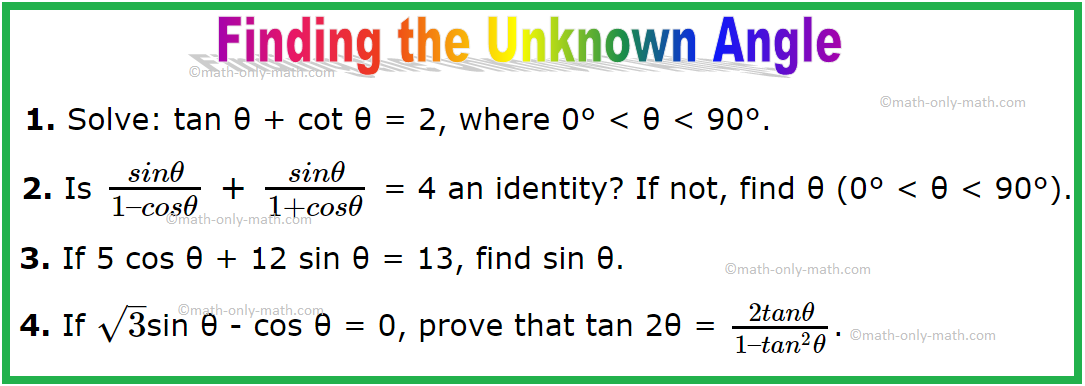Subscribe to our ▶️ YouTube channel 🔴 for the latest videos, updates, and tips.
Finding the Unknown Angle
Problems on finding the unknown angle using trigonometric identities.
1. Solve: tan θ + cot θ = 2, where 0° < θ < 90°.
Solution:
Here, tan θ + cot θ = 2
⟹ tan θ + \(\frac{1}{tan θ}\) = 2
⟹ \(\frac{tan^{2} θ + 1}{tan θ}\) = 2
⟹ tan\(^{2}\) θ + 1 = 2 tan θ
⟹ tan\(^{2}\) θ - 2 tan θ + 1 = 0
⟹ (tan θ - 1)\(^{2}\) = 0
⟹ tan θ – 1 = 0
⟹ tan θ = 1
⟹ tan θ = tan 45°
⟹ θ = 45°.
Therefore, θ = 45°.
2. Is \(\frac{sin θ}{1 – cos θ}\) + \(\frac{sin θ}{1 + cos θ}\) = 4 an identity? If not, find θ (0° < θ < 90°).
Solution:
Here, LHS = \(\frac{sin θ(1 + cos θ) + sin θ(1 - cos θ)}{(1 – cos θ)(1 + cos θ)}\)
= \(\frac{2sin θ}{1 – cos^{2} θ}\)
= \(\frac{2sin θ}{sin^{2} θ}\), [using trigonometric identities, sin\(^{2}\) θ + cos\(^{2}\) θ = 1]
= \(\frac{2 }{sin θ}\)
Thus, the given equality becomes \(\frac{2 }{sin θ}\) = 4.
Now, if the equality holds true for all values of θ then the equality is an identity.
Let us take (arbitrarily) θ = 45°.
So, \(\frac{2 }{sin 45°}\) = \(\frac{2 }{\frac{1}{√2}}\) = 2√2
So, sin θ ≠ 4.
Therefore, the equality is not an identity.
It is an equation. Then, from the equation we have,
\(\frac{2}{sin θ}\) = 4
⟹ sin θ = \(\frac{1}{2}\)
⟹ sin θ = sin 30°
Therefore, θ = 30°.
3. If 5 cos θ + 12 sin θ = 13, find sin θ.
Solution:
5 cos θ + 12 sin θ = 13
⟹ 5 cos θ = 13 - 12 sin θ
⟹ (5 cos θ)\(^{2}\) = (13 – 12 sin θ)\(^{2}\)
⟹ 25 cos\(^{2}\) θ = 169 - 312 sin θ + 144 sin θ\(^{2}\)
⟹ 25(1 - sin\(^{2}\) θ) = 169 - 312 sin θ + 144 sin θ\(^{2}\), [using trigonometric identities, sin\(^{2}\) θ + cos\(^{2}\) θ = 1]
⟹ 25 – 25 sin\(^{2}\) θ = 169 – 312 sin θ + 144 sin θ\(^{2}\),
⟹ 169 sin\(^{2}\) θ – 312 sin θ + 144 = 0
⟹ (13 sin θ – 12)\(^{2}\) = 0
Therefore, 13 sin θ – 12 = 0
⟹ sin θ = \(\frac{12}{13}\).
4. If \(\sqrt{3}\)sin θ - cos θ = 0, prove that tan 2θ = \(\frac{2 tan θ}{1 – tan^{2} θ}\).
Solution:
Here, \(\sqrt{3}\)sin θ - cos θ = 0
⟹ \(\frac{sin θ}{cos θ}\) = \(\frac{1}{\sqrt{3}}\)
⟹ tan θ = \(\frac{1}{\sqrt{3}}\)
⟹ tan θ = tan 30°
⟹ θ = 30°
Therefore, tan 2θ = tan (2 × 30°) = tan 60° = √3
Now, \(\frac{2 tan θ}{1 – tan^{2} θ}\) = \(\frac{2 tan 30°}{1 – tan^{2} 30°}\)
= \(\frac{2 × \frac{1}{\sqrt{3}}}{1 – (\frac{1}{\sqrt{3}})^{2}}\)
= \(\frac{\frac{2}{\sqrt{3}}}{1 – \frac{1}{3}}\)
= \(\frac{\frac{2}{\sqrt{3}}}{\frac{2}{3}}\)
= \(\frac{2}{√3}\) × \(\frac{3}{2}\)
= √3.
Therefore, tan 2θ = \(\frac{2 tan θ}{1 – tan^{2} θ}\). (proved)
From Finding the Unknown Angle to HOME PAGE
Didn't find what you were looking for? Or want to know more information about Math Only Math. Use this Google Search to find what you need.



New! Comments
Have your say about what you just read! Leave me a comment in the box below. Ask a Question or Answer a Question.